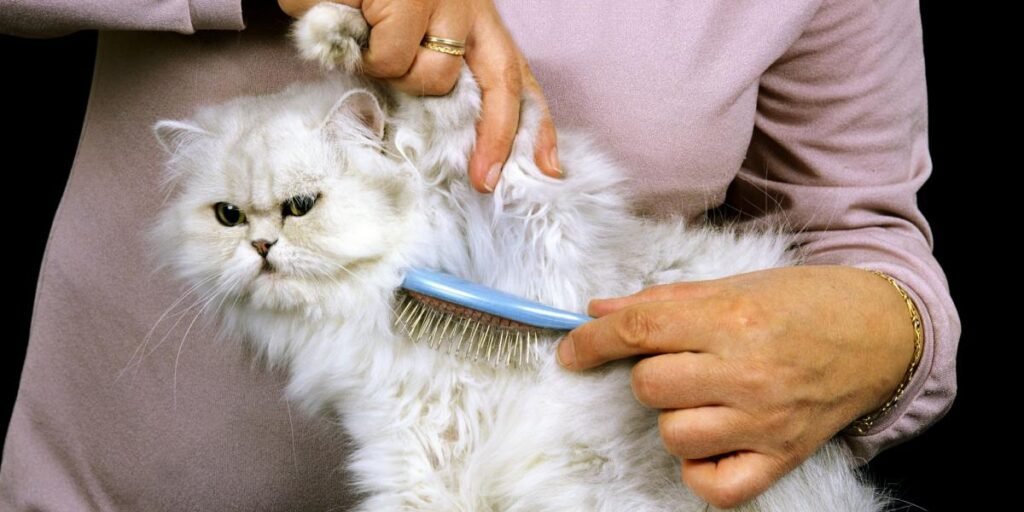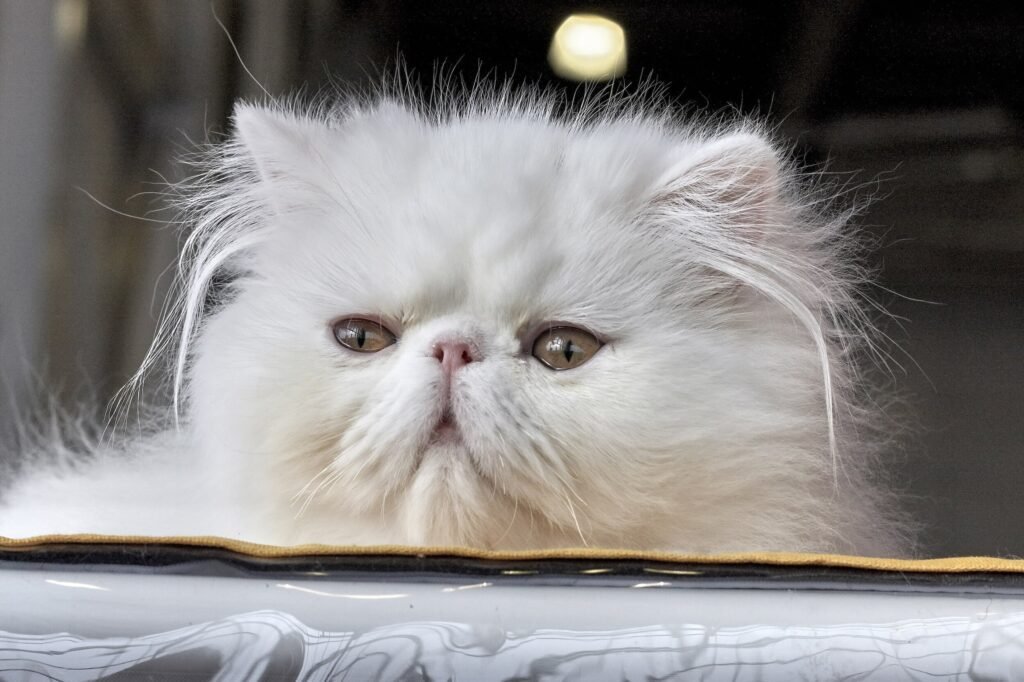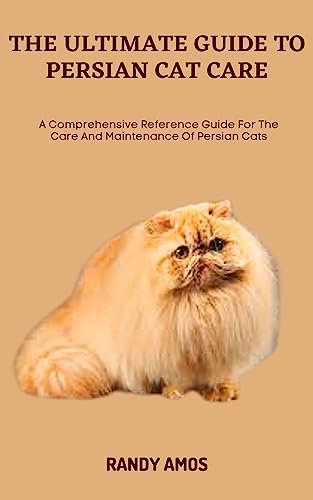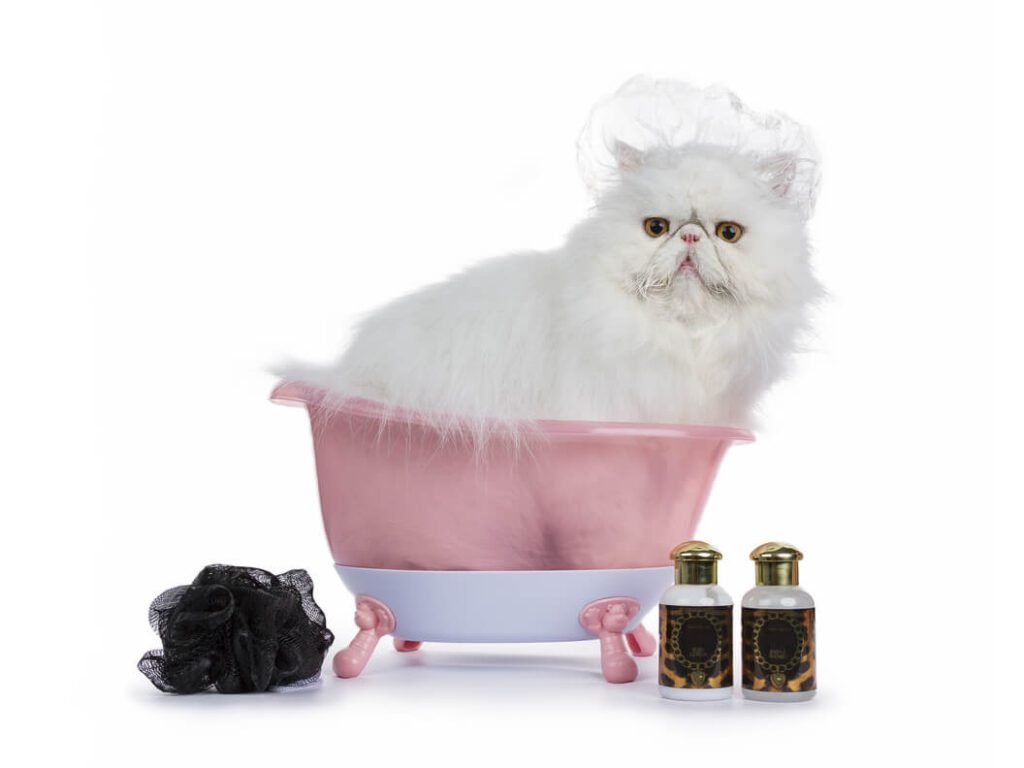Are you a proud owner of a Persian cat or thinking about adopting one? If so, then you’ve come to the right place! In this ultimate guide, you will discover all the tips and tricks on how to groom your furry friend and keep their luxurious coat in top-notch condition. From brushing techniques to bathing routines, we’ve got you covered. So get ready to pamper your Persian cat and ensure their grooming experience is nothing short of purrfection!


This image is property of cats.com.
1. Understanding the Persian Cat
Physical characteristics of a Persian cat
The Persian cat is known for its distinctive physical characteristics. It has a round face with a flat nose and large round eyes, giving it an adorable and charming appearance. The breed is known for its luxurious, long, and dense coat that comes in a variety of colors and patterns. Persians have a sturdy and muscular body with short legs and a relatively short tail. Their overall appearance is one of elegance and grace.
Common health issues in Persian cats
Although Persian cats are generally healthy, they are prone to certain health issues that require special attention. One common problem that Persian cats face is breathing difficulties due to their flat face. This can lead to issues like snoring and wheezing. Additionally, their dense coat makes them susceptible to skin conditions and matting. They are also prone to eye problems such as excessive tearing and eye infections, as well as dental issues. Regular grooming and veterinary check-ups are essential to keep your Persian cat in good health.
Why grooming is essential for Persian cats
Grooming plays a vital role in maintaining the health and well-being of Persian cats. Their long and dense fur requires regular grooming to prevent tangles, mats, and skin issues. Grooming also helps to remove loose hair and reduce shedding, keeping your home cleaner. Proper grooming promotes healthy skin and a shiny coat while allowing you to monitor your cat’s overall health. It also provides an opportunity for bonding and strengthens the relationship between you and your Persian cat.
2. Preparing for Grooming
Gather the necessary grooming supplies
Before you begin grooming your Persian cat, make sure you have all the necessary supplies. This includes a slicker brush, a wide-toothed comb, a mat splitter (if needed), cat-friendly shampoo, a towel, cotton balls, an ear cleaning solution, cat-safe nail clippers, and toothbrush and toothpaste designed specifically for cats. Having these supplies readily available will ensure a smooth and efficient grooming session.
Create a calm and comfortable environment
Creating a calm and comfortable environment is essential for a successful grooming session. Find a quiet and well-lit area where you can comfortably groom your cat. Make sure the room is warm enough to keep your cat relaxed. Eliminate any potential distractions and keep other pets away during the grooming process. Providing a familiar and comfortable space will help your Persian cat feel at ease and make the grooming experience more enjoyable.
Introduce your Persian cat to grooming gradually
If your Persian cat is not accustomed to grooming, it is important to introduce them to the process gradually. Start by gently brushing their coat for a few minutes each day, gradually increasing the duration over time. Use positive reinforcement, such as treats and praise, to reward your cat for their cooperation. This will help your cat associate grooming with positive experiences and reduce anxiety or stress associated with the process.
3. Brushing and Combing
Choosing the right type of brush for your Persian cat’s coat
When it comes to brushing your Persian cat’s long and dense coat, choosing the right type of brush is crucial. A slicker brush or a bristle brush with long, fine bristles works well for removing loose hair and preventing tangles. Additionally, a wide-toothed comb is useful for detangling and removing any remaining knots or mats. It is important to invest in high-quality brushes and combs to ensure they effectively remove tangles without causing discomfort to your cat’s skin.
Techniques for effective brushing and combing
To ensure effective brushing and combing, start by gently brushing the outer layer of your Persian cat’s coat, working your way from the head to the tail. Be extra gentle around sensitive areas such as the belly and underarms. If you encounter any tangles or mats, use your fingers or a mat splitter to carefully separate them. Regular brushing is essential to prevent matting, as it can lead to discomfort and skin issues.
Dealing with tangles and mats
Tangles and mats are common in Persian cats due to their long and dense fur. To deal with tangles, start by gently teasing them apart with your fingers or a wide-toothed comb. For more stubborn mats, use a mat splitter to carefully cut through the mat, being cautious not to pull your cat’s hair. If the mat is too close to the skin or too extensive, it is best to seek professional help to avoid causing any injuries or distress to your cat.
4. Bathing and Drying
Frequency of bathing a Persian cat
Persian cats generally do not require frequent bathing unless they get excessively dirty. Bathing every 4 to 6 weeks is usually sufficient for maintaining cleanliness and a healthy coat. However, if your cat has specific skin conditions or is prone to matting, your veterinarian may recommend more frequent bathing. It is important not to overdo bathing, as it can strip the natural oils from the coat and cause dryness or irritation.
Selecting a cat-friendly shampoo
When bathing your Persian cat, it is important to choose a shampoo specifically formulated for cats. Human shampoos or harsh chemicals can be too harsh for their sensitive skin. Look for a cat-friendly shampoo that is gentle, hypoallergenic, and specifically designed to promote a healthy coat. It is advisable to consult with your veterinarian to determine the most suitable shampoo for your Persian cat’s specific needs.
Proper bathing and drying techniques
Before bathing your Persian cat, thoroughly brush their coat to remove any tangles or loose hair. Use lukewarm water to wet their coat, avoiding their face and ears. Apply a small amount of cat-friendly shampoo and gently massage it into their fur, ensuring all areas are covered. Rinse thoroughly to remove all shampoo residue, and then carefully towel-dry your cat. Avoid using a blow dryer unless your cat is comfortable with the noise and warm air. It is important to ensure your Persian cat is completely dry before allowing them to walk or go outside to prevent them from getting cold or developing skin issues.


This image is property of Amazon.com.
5. Maintaining Eye and Ear Hygiene
Cleaning your Persian cat’s eyes
Persian cats are prone to excessive tearing, which can lead to staining and discomfort. To maintain good eye hygiene, gently clean your cat’s eyes using a sterile saline solution or a specialized cat eye wipe. Moisten a cotton ball or pad and gently wipe away any discharge or debris from the corners of their eyes. Take care not to touch the eyeball directly and avoid using any harsh or scented products near their eyes.
Checking for signs of eye infections or irritations
Regularly checking your Persian cat’s eyes is important to identify any signs of infections or irritations. Look for redness, discharge, or swelling around the eyes. Excessive squinting or rubbing of the eyes may also indicate a problem. If you notice any of these signs or if your cat’s eyes appear painful or uncomfortable, it is important to seek veterinary attention promptly. Early detection and treatment can prevent further complications and discomfort for your cat.
Caring for your cat’s ears
Persian cats are prone to ear infections and excessive wax buildup due to the shape of their ears. Regular ear cleaning is essential to maintain ear health. Use a cat-friendly ear cleaning solution and a cotton ball or soft cloth to gently wipe the outer part of the ear. Avoid inserting anything inside the ear canal to prevent injury. If you notice any signs of infection, such as redness, swelling, or a foul odor, it is crucial to consult your veterinarian for appropriate treatment.
6. Trimming Nails
Importance of regular nail trimming
Regular nail trimming is essential for the health and comfort of your Persian cat. Overgrown nails can cause pain, discomfort, and difficulty in walking or climbing. Additionally, long nails are more prone to breakage or getting caught in various objects, leading to injuries. By keeping your cat’s nails trimmed, you minimize these risks and help maintain their overall well-being.
Tools needed for safe nail trimming
To safely trim your Persian cat’s nails, you will need cat-safe nail clippers or a nail grinder specifically designed for cats. Traditional human nail clippers or sharp scissors can cause injury or discomfort. It is important to choose tools that are appropriate for your cat’s size and nail thickness. Have styptic powder or cornstarch on hand to quickly stop any bleeding in case you accidentally cut the nail too short.
Step-by-step guide for trimming your Persian cat’s nails
- Choose a quiet and comfortable area for nail trimming.
- Gently hold your cat’s paw and apply light pressure to extend the nail.
- Identify the translucent area, called the quick, in each nail. Be cautious not to cut into the quick, as it can cause bleeding and discomfort.
- Trim the nail by making a quick and clean cut, slightly angled away from the quick.
- If your cat is anxious or resistant, take short breaks between each nail and offer treats or praise as a reward.
- If you accidentally cut into the quick and bleeding occurs, apply styptic powder or cornstarch to stop the bleeding. Monitor your cat for any signs of pain or discomfort.


This image is property of images.squarespace-cdn.com.
7. Dental Care
Understanding the importance of dental hygiene for cats
Dental care is often overlooked but is crucial for the overall health of your Persian cat. Poor dental hygiene can lead to a range of issues, including dental disease, tooth loss, and pain. Tartar buildup and gum disease can also affect your cat’s overall well-being and may even lead to more severe health problems such as heart disease. Regular dental care, including toothbrushing and routine dental check-ups, is essential to maintain healthy teeth and gums.
Introducing toothbrushing to your Persian cat
Toothbrushing should ideally be introduced to your Persian cat at a young age, but it is never too late to start. Begin by gradually getting your cat used to the process. Start by gently touching their mouth and teeth with your finger. Once they are comfortable with this, introduce a cat-specific toothbrush and toothpaste. Use a small amount of toothpaste and gently brush their teeth in a circular motion. Gradually increase the duration and frequency of brushing over time.
Alternative dental care methods
If your Persian cat is resistant to toothbrushing, there are alternative dental care methods available. Dental treats and toys designed specifically for cats can help promote oral health by reducing plaque and tartar buildup. Additionally, dental rinses or water additives can be used to maintain oral hygiene. However, it is important to remember that these alternatives should complement, not replace, regular toothbrushing and professional dental cleanings.
8. Handling Knots and Matting
Identifying and treating knots and matting
Knots and matting can occur in your Persian cat’s fur, particularly in areas such as the armpits, belly, and behind the ears. These tangles can be uncomfortable and potentially lead to skin issues if left untreated. Regular brushing and combing can help prevent matting, but if you come across knots, it is important to address them promptly. Use your fingers or a wide-toothed comb to gently tease out the tangles, working from the edges towards the center. Be patient and avoid pulling on the hair, as it can cause pain and distress to your cat.
Using detangling products or home remedies
Detangling sprays or leave-in conditioners can be helpful in loosening knots and making them easier to comb through. These products make the hair smoother and less likely to tangle. Alternatively, you can create a homemade detangling solution by mixing a small amount of conditioner with water in a spray bottle. Lightly mist the affected area and gently comb through the tangles. Be cautious not to use too much product, as it can make the coat sticky or greasy.
When to seek professional help
While regular grooming at home can help prevent most matting issues, there may be instances where professional help is necessary. If the matting is extensive, close to the skin, or if your cat becomes excessively stressed or distressed during grooming, it may be best to consult a professional groomer. They have the expertise and tools required to safely and effectively handle severe matting situations without causing discomfort or injury to your cat.


This image is property of Amazon.com.
9. Grooming Exotic Persian Features
Maintaining a healthy flat face
The unique flat face of Persian cats requires special attention to maintain their health and well-being. Regular cleaning of the face is important, as tear stains can occur due to excessive tearing. Gently wipe the area with a soft cloth or specialized cat wipes to remove any discharge or debris. Pay extra attention to the folds on the face, ensuring they are clean and dry to prevent bacterial or fungal infections. Be careful not to pull on the skin or irritate the eyes during this process.
Caring for your Persian cat’s long fur
The long fur of Persian cats is one of their most distinctive features but also requires diligent care. Regular brushing and combing are necessary to prevent tangles, mats, and excessive shedding. Invest in high-quality grooming tools suited for long-haired cats to effectively maintain their coat. Consider scheduling professional grooming sessions every few months to keep their fur in optimal condition. Additionally, a balanced diet rich in essential nutrients can contribute to healthy skin and a shiny coat.
Special attention to the Persian cat’s tail
The tail of a Persian cat is an elegant feature that requires special attention during grooming. Regular brushing and combing are essential to prevent tangles and matting in this area. Be gentle and take extra care when working through any knots or mats, as the tail is a sensitive area for your cat. If you notice any abnormalities, such as redness or swelling, or if your cat becomes uncomfortable or in pain during grooming, consult with your veterinarian for further evaluation and guidance.
10. Professional Grooming and Additional Tips
Benefits of professional grooming for Persian cats
While regular grooming at home is necessary, there are several benefits to occasional professional grooming for your Persian cat. Professional groomers have the expertise and specialized equipment to handle various grooming needs, such as extensive matting or intricate haircuts. They can thoroughly clean and groom hard-to-reach areas, ensuring your cat’s coat and skin are in optimal condition. Professional grooming can also provide a fresh start and an opportunity to address any specific concerns or issues.
Finding a reputable groomer
When searching for a professional groomer for your Persian cat, it is important to choose a reputable and experienced individual or salon. Seek recommendations from other pet owners or your veterinarian. Visit the grooming facility beforehand and ask about their grooming techniques, products used, and if they have experience with Persian cats. A skilled groomer should also prioritize the comfort and safety of your cat throughout the grooming process.
Other grooming tips and tricks for Persian cat owners
In addition to regular grooming routines, there are a few additional tips and tricks for Persian cat owners:
- Regularly check for foreign objects or debris stuck in your cat’s fur, especially around the paws or tail.
- Use gentle and positive reinforcement techniques to keep your cat calm and relaxed during grooming sessions.
- Provide your Persian cat with a well-balanced diet to promote healthy skin and a shiny coat.
- Monitor your cat’s weight to prevent obesity, as excess weight can make grooming more challenging and lead to additional health issues.
- Encourage playtime and exercise to keep your cat physically and mentally stimulated, which can contribute to a healthy coat and overall well-being.
By following these grooming tips and providing proper care, you can ensure that your Persian cat remains healthy, happy, and beautiful for years to come. Grooming is not only a necessary aspect of cat ownership, but it is also an opportunity for you to bond with your furry friend. Take the time to establish a grooming routine and make it a positive and enjoyable experience for both you and your Persian cat.


This image is property of lolcats.com.

